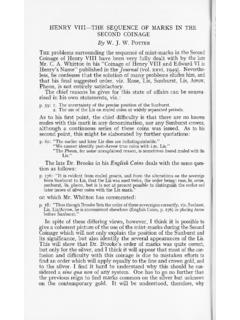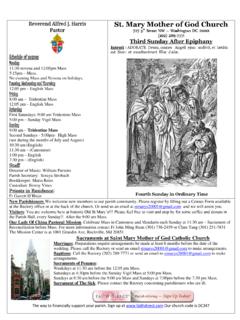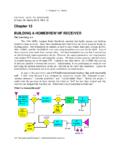Transcription of ROYAL CHARITIES. - britnumsoc.org
1 ROYAL charities . (SECOND SERIES.) PART III.. By HELEN FARQUHAR. Largesse and the King's Dole. D N the British Numismatic Journal, vol. xvi, pp. I95-228, we passed in review the subject of Maundy, the name given to a special distribution of charities on Holy Thurs-day in particular. But we saw also that many other ROYAL benefactions came, whether rightly or wrongly, to be included under this designation. I therefore thought it well, before giving actual details of the Maundy, connected with the service of washing the feet of the poor, to clear the ground of other distributions-the Daily Alms, the Poor at the Gate, and the Privy Alms. This I did in the latest volume of the British Numismatic Journal (vol. xvii, pp. I33-64) There remains yet another form of almsgiving, making a call on the small currency, which, on passing through the hands of the ROYAL Almoner, may have sometimes necessitated a special issue of groats and half-groats.
2 This general almsgiving may be called " Largesse," a part of " The King's Dole," being money thrown to the crowd on the ROYAL journey, as on the travels of other great personages. But the "King's Dole" proper was given by fixed rule at Eastertide to the general public, whether by the Monarch him-self or by his Almoner as the circumstances of the moment dictated. The "Largesse" in particular, although the least important of these distributions, shall take precedence because it requires little explanation, ROYAL charities . Largesse. At all times of particular pageantry, such as a coronation, a marriage, or a progress, money was always given to the poot, and this" Largesse" was often dispensed by our early kings on a very large scale. Holinshed, writing of William II's visit to "gratifie the people" at Winchester in 1087, after his Coronation, chronicles his munificence.
3 It appears that he "found greate treasure which his father had laid vp there, for his owne vse, this he freelie spent in large gifts and all kinds of prinselie largesse."l It may be objected that we have here probably very much larger benefactions and more individual than the scattering of small coin, which would at that date, and throughout the reign of the Norman Kings, take the form of single pence. But William's PENNIES OF WILLIAM I AND WILLIAM II. prodigality, like John's feasts, of which we gave examples in our last volume,2 no doubt proceeded from a desire to buy the goodwill of a reluctant populace rather than a charitable wish to ease the burdens of the poor. We have noticed that the money laid aside for distribution in. Mary Tudor's first regnal year3 exceeded that dispensed in any ordinary year of her late brother's reign. We must therefore take into consideration that a liberal scattering of small coin would be desirable 1 Holinshed's Chronicle, ed.
4 Of 1807, vol. ii, p. 27. The Coronation had taken place on September 26, 1087. 2 British Numismatic Jo~trnal, vol. xvii, pp. 136-8 and 14I. 3 Trevelyan Papers, part ii, published by the Camden Society in 1862, pp. 35-7. " Office of Tnresaurer of the Quenes Majesties Chamber viij Marcij Anno primo-Marire Reginre." f Largesse and the King's Dole. at her Coronation, her accession to the throne being by no means universally approved. There was no time to be lost, and having been proclaimed Queen on July 13, a week after her brother's death, she was crowned on October I, 1553. The conduits at Cornhill and Cheapside ran freely with wine/ and, as Strype tells us, "all was resolved to be very splendid and glorious." The Queen was presented by the City of London with a purse containing 1,000 marks of gold. The mark was money of account, and it is not specified in what form the offering was made; most likely it would take the shape of two thousand angels of the late King.
5 But there is no evidence to show that such presentations aimed at uniformity. Mary's own gold was not avail-able. The groat, which gives us the first numismatic portrait of the Queen, was figured in our last volume,2 but at her Coronation it is not recorded that she personally scattered coin to the people. MARY'S ANGEL: FIRST COINAGE. The first indenture between the" Sovereign Lady Mary" and her money-makers at the Tower, is, as Mr. Henry Symonds has shown us, of August 20, 15533; but it seems unlikely that groats bearing her portrait should have been ready for" Largesse" by the Coronation day, although angels for her" Healings" were specially prepared for her in the following Before her marriage, which was not until the ensuing July, her silver consisted in small coins, groats, half-groats, and pence 1 Quoted by Planche in Regal Records, p. 10.
6 2 British Numismatic J ournal, vol. xvii, p. 156. 3 Brit. lVhts. 'vlS., 660. British Numismatic Jour-nal, vol. viii, p. 180. 4 Ibid., p. 185. F 66 ROYAL charities . only, and, therefore, she may on progress have been in a position to present her portrait to the people. Money thrown to the crowd, if a coronation did not immediately follow the accession, might bear the ROYAL effigy, but was in Stuart times replaced by a coronation medal. We know that when Charles I was crowned at Edinburgh, the Bishop of Moray, who had been constituted Almoner, threw out among the people certain silver pieces struck in honour of the CHARLES I SCOTTISH CORONATION MEDAL. These medals are by Briot. But under this King the thin silver medalet of little or no intrinsic value had already made its appearance, and took the place of the scattered coin on special occasions such as a coronation or marriage.
7 Not, however, on progress was this the case, for the old custom still prevailed of giving actual coin to the poor. Nevertheless, so late as I762, when Catherine of Russia was crowned, we read that she was ostentatious in her generosity. "The merry making was prolonged," says her biographer, "for weeks, the fountains ran with wine, bread and roast meat were given for the asking, and silver roubles were thrown to the people."2 Here, again, we have an instance, when it' was deemed prudent to buy popularity. At a coronation the distributor of alms was the Hereditary Grand Almoner, who claimed the silver dish in which they were carried as his 1 ROYAL Palaces of Scotland, p. 22, and Medallic Illustrations, vol. i, pp. 265-6, Nos. 59-61. 2 Catherine the Great, by Katherine Anthony, p. 180. Catherine was crowned on September 23, 1762, at Moscow, not quite three months after her succession.
8 3 Glory of Regality, by Arthur Taylor, p. II7. Largesse and the King's Dole. It was the custom of all great banquets, such as those at Yule-tide and not at a coronation only, that the cry of "Largesse" should be raised by the Heralds. The entries in the Tudor accounts are minute as to this" Largesse," and we might think at first sight that we have the opportunity of calculating exactly how much money was needed for the ROYAL distribution. But this is not the case, for the " Largesse" claimed by the Herald was his own perquisite, and not for distribution, and the" almes," although regularly administered by the ROYAL Almoner, were frequently given to any passer-by at the hands of the King'S' retainers. Thus, in the accounts of Henry VIII, we read, under date October 7, 1532: "The same daye paied to Thomas foteman to. dispose in Almesse by the way towards Shepay iijS This is a sum which, although probably distributed in pennies, is divisible into groats or demi-groats.
9 Or, again, in April, 1501, " Itrn to Hugh Denes for Almes at ij tymes XVS,"2 under Henry VII. Hugh Denes or Denys was probably a Gentleman-in-Waiting on the King, for we often find small payments made to him, such as " ixs iiijd," or " xS," or " xiijS iiij<1 for the King."z HENRY VII PENNY, I500. But this promiscuous charity was not peculiar to Henry himself. Stow, in his Survey of London, mentions that "Richard Redman, Bishop of Elie, 1500, the 16 of Henrie the seventh .. wheresoever he lodged in his trauailling, when at his coming or going to or from any towne, the belles being rung, all the poor would come togither, to whom he gaue eury one 6d. at least."3 In the curiously minute accounts of the fifteenth, sixteenth and seventeenth centuries, 1 Privy Purse Account of Henry VIII, from November, I529, to December, I532, edited by Nicholas Harris Nicolas, p.
10 265. 2 Exchequer Accounts Various. MS., Public Record Office, Bundle 4I5; 3 Stow's Survey of London, Kingsford's ed. of I908, vol. i, p. 88. F 2 68 ROYAL charities . we meet with entries of even one penny given to beggars by the way. The accounts, for instance, of the Duchess of Suffolk, from r560 to r562, reveal such charities as the following: "To the prisoners at Huntington as her grace passed throwe 20d. To a poore Woman by the waye 4d."1 ELIZABETH MILLED GROAT AND HALF-GROAT (MINT-MARK, STAR), 1560-1. But let us turn from this great lady of Elizabethan times to . the grandfather of the Lord Protector, Oliver Cromwell, one Sir Henry Cromwell, known as the" Golden Knight," on account of his prodigality. Sir Henry, who died in r602-3, was the father of one Sir Oliver, who sold Hinchingbrooke in r627 to the Montagues, perhaps on account of Sir Henry's extravagance.













